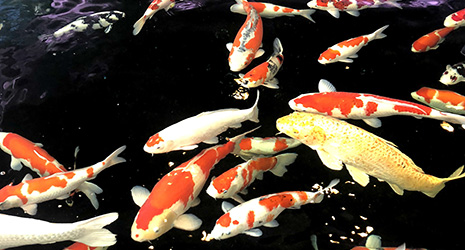April 2020
Swimming Jewels

First bred long ago in a remote mountain village in Niigata Prefecture, nishikigoi ornamental carp now have admirers around the world.
Nishikigoi are large ornamental carp (koi) of Japanese origin now found in ponds around the world, where they are admired for their beautiful colors, unique patterns and approachability. The fish were first bred around 200 years ago in a mountainous area then called Nijyumurago near present-day Ojiya City in Niigata Prefecture. The name “nishikigoi” came into use as the bright colored patterns of the fish are evocative of nishiki, or brocade, a high-quality woven fabric. The fish are also known colloquially as “swimming jewels.”
The Nishikigoi no Sato (Nishikigoi Village) tourist facility in Ojiya City, the birthplace of nishikigoi, features a Japanese-style garden with four ponds where approximately 340 nishikigoi carp in twenty species are bred. People can enjoy watching the nishikigoi swim gracefully in front of them all year round.
“Located in a steep mountainous area with a lot of snow in winter, the people in Nijyumurago had difficulty securing food in the winter,” says Hirasawa Katsuyoshi, the manager of Nishikigoi Village. “They therefore bred edible carp to be a precious source of protein. The hamlet was often snowed in, and the villagers had nothing that could really be called entertainment. It is understood that they consequently became intrigued by the slight differences in the colors and patterns of the carp they were raising, and started to engage in selective breeding in their own original way.”
The people of Nijyumurago had been growing rice from water supplied by the mountains in terraced paddies carved into the steep landscape. However, the snowmelt draining into the paddies was so cold that rice did not grow properly. So they created ponds, called tanaike, to retain water in the uppermost terrace, which was then supplied to the rice paddies after it had been warmed by the sun. This combination of rice field terraces and tanaike is a rare landscape feature in the world, and a beautiful one.

In addition to irrigating the rice fields, the tanaike were also used to raise edible carp. At first the carp were the dark gray colored variety known as magoi, but it happened that some slightly reddish carp and some with patterns were born due to genetic mutation. At the same time, there was a different type of wild carp called asagi that had indigo or light blue bodies and red pectoral fin areas. People were intrigued by these carp with their colorful, patterned bodies and interbred them with the domestic carp to create nishikigoi with a broader range of beautiful colors and patterns.
Nowadays there are more than 100 varieties of nishikigoi. The Fishery Cooperative of Ojiya City Nishikigoi includes approximately sixty nishikigoi breeders, and 80–90% of their nishikigoi are exported overseas.
Needless to say, beautiful colors and balanced patterns are important factors in nishikigoi appreciation. In competitions, other desirable traits in a fish include having a voluminous and well-balanced body shape with a straight spine, vividness, glossiness, and neat scale patterns.
“The thing we pay the most attention to in breeding nishikigoi is the development of the right water. Having water that is too clean isn’t good because we lose the natural bacteria that purify the water. We measure the oxygen concentration, pH level and water temperature every day to maintain the water quality suitable for the breeding of nishikigoi,” says Hirasawa.
Nishikigoi are known as a “symbol of peace” because their schools do not have a controlling boss and individual fish do not engage in bullying. The peaceful creatures also get used to humans easily. Thanks to their excellent adaptability to their surroundings, nishikigoi grow to a large size if raised in large ponds but will not grow excessively if they are raised in smaller garden ponds. The number of nishikigoi lovers is rising because people can enjoy watching the fish in ponds of all sizes, whatever their living circumstances.

